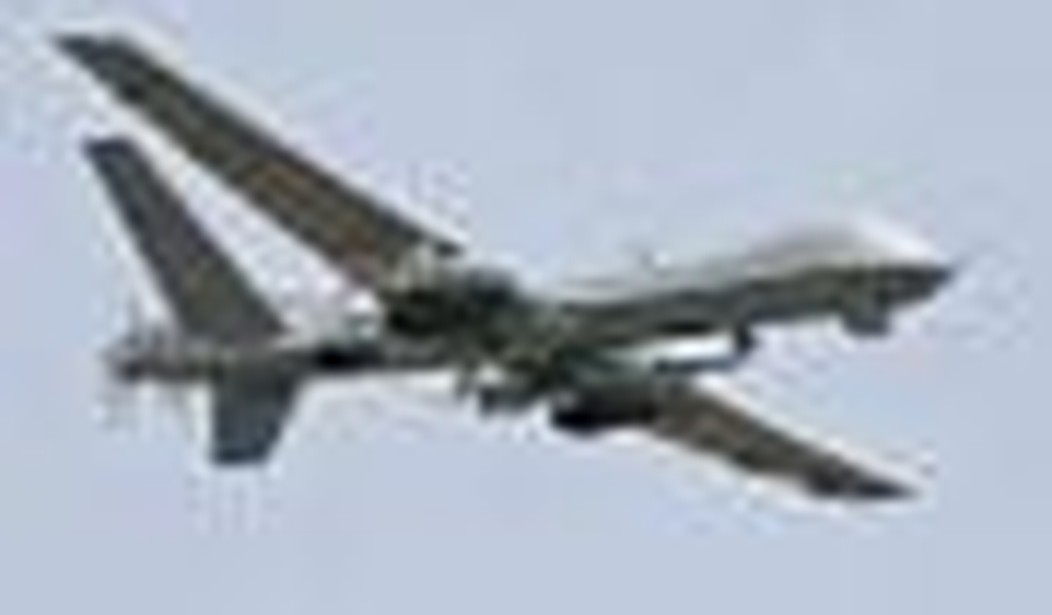On Victory over Japan Day, also known as V-J Day, General Henry “Hap” Arnold told the world that “the next war may be fought by airplanes with no men in them at all.” He was off by two and a half wars.
Last week, after passing a federal security clearance, I was privileged to visit Creech Air Force Base in Indian Springs, Nevada, where the 432nd Wing currently flies airplanes without men over Iraq, Afghanistan, and Pakistan. The drones, called the MQ-1 Predator and the MQ-9 Reaper, fly above the conflict zones while their pilots sit in chairs 50 miles outside Las Vegas. It was from there that I, wearing a business suit and suede shoes, witnessed live action on the battlefield from over the drone pilot’s shoulder.
“Take everything you’ve learned about aviation in war, throw it out of the window, and let’s go to work on tomorrow’s aviation,” General Arnold told his men. “It will be different from anything the world has ever seen.” How true were the general’s words.
Chances are as a 42-year-old mother of two young boys, I would never have witnessed live action in a war zone were this World War II, Korea, or Vietnam. And while drones have been in battle since World War II (Joe Kennedy died on a drone mission), only in the war on terror have they taken center stage. At Creech, Hap Arnold’s prediction of war unlike anything the world has ever seen before unfolded in front of my eyes. There I was, watching Afghan sheep slumber outside a building that had suspected enemy combatants inside — in real time.
The drones are remarkable to watch in action. Video screens in front of the pilot display satellite images of what is going on down on the ground in varying degrees of close-up. The best resolution is such that in addition to seeing those black sheep on the ground, I could see shrubs and concrete blocks. The Predator relaying this real-time video feed was flying at 20,150 feet above the scene. While some Predators are equipped with Hellfire missiles, others are not. Those without missiles have maximum surveillance capabilities and carry a camera equipped with synthetic aperture radar, or SAR. (Predators can’t currently carry both SAR systems and Hellfire missiles.)
Other countries including Iran currently fly surveillance drones, but no other country has SAR cameras on their pilotless aircraft. When a Predator is equipped with a SAR package, it can see through smoke, dust, clouds, and even heavy rain. SAR systems can also robotically recognize ground images captured before. “If we leave a site after being parked over it for a while and come back later, we can determine if anything about that site has changed,” the 432nd Wing’s chief of staff, Lt. Col. Lance King, explained.
Before the war on terror, the Air Force, which prided itself on its airmen, was loath to fly drones. A traditional pilot used to spend 18 months learning to fly at the cost of one million taxpayer dollars. Not so anymore. On September 25, the Air Force graduated its first class of Predator pilots who had not gone through any kind of traditional pilot training and had no experience in the air. If Vice President Joe Biden gets his way, the war on terror will soon be largely fought by drones. (President Obama says he will reject the so-called Biden option; time will tell.)
The Air Force appears to be betting on drones. Lt. Col. Lance King told me that next year an estimated 300 more pilots will graduate from this same program that just graduated the nation’s first twenty-five. “They can’t train them fast enough,” King said. “We are running out of guys. … We’ve had 125,174 hours of [drone] flying time in the first nine months of this year.”
Here’s an interesting note I’ve not seen reported elsewhere. Despite the increase in unmanned drones and their armchair pilots, the number of actual missile strikes in the war theater is on its way down. Lt. Col. Lance King explained: “In 2007 there were 112 hellfire shots, in 2008 there were 132, but in 2009 there were only 87. The reason the strikes are going down is because we are able to stop things earlier. Before it comes to that.”
To this end, I saw a videotape of what happens after the Predator helps determine that enemy combatants are hiding out inside a building. This particular warehouse-like structure, alone in a desert landscape, was also ringed with small black sheep. Two U.S. Army helicopters swept in. The sheep scattered. The troops rappelled down ropes and stormed into the building. After a few minutes the back door of the building opened and a figure, labeled “HV-1” (high value target one), escaped out the door. The Predator followed “HV-1” as he ran across the desert floor, relaying coordinates to a second U.S. Army helicopter in the area. That helicopter swept in and landed, soldiers leapt out, and they captured “HV-1” alive.
At Creech, the Air Force is at work on General Arnold’s concept of “tomorrow’s aviation.”









Join the conversation as a VIP Member